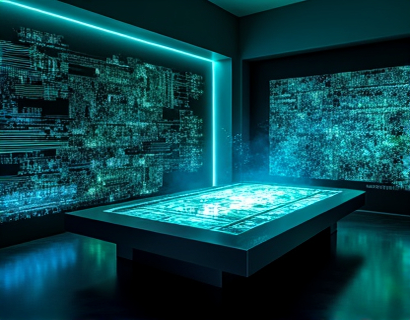AI-Driven Exploration of Egyptian Heritage: Insights and Authentic Artifact Shopping Experience
In the realm of ancient civilizations, few hold as much fascination and mystique as Ancient Egypt. The pyramids, the hieroglyphs, the gods and pharaohs - all elements that have captivated human imagination for millennia. Today, with the advent of artificial intelligence, the study and appreciation of Egyptian heritage have reached new heights. This article delves into how AI technology is revolutionizing our understanding of Ancient Egypt, offering profound insights and a unique shopping experience for authentic artifacts.
Unveiling Ancient Secrets with AI
The integration of AI in the study of Ancient Egypt has opened up unprecedented avenues for research and discovery. AI algorithms, capable of processing vast amounts of data, have become invaluable tools for archaeologists and historians. These technologies assist in deciphering hieroglyphs, analyzing artifacts, and even reconstructing ancient environments. For instance, machine learning models can recognize patterns in hieroglyphic inscriptions, aiding in translations and providing deeper insights into the language and culture of the Egyptians.
One of the most significant contributions of AI is in the field of artifact authentication. Through advanced imaging techniques and pattern recognition, AI can help distinguish genuine artifacts from replicas. This is crucial for collectors and museums, ensuring that the items they possess and display are authentic pieces of history. The precision and accuracy offered by AI in this context are unparalleled, providing a level of confidence that traditional methods cannot match.
Enhanced Educational Resources
The educational value of AI in exploring Egyptian heritage cannot be overstated. Interactive platforms powered by AI offer immersive learning experiences, allowing enthusiasts and students to explore ancient Egypt in a dynamic and engaging way. Virtual reality (VR) and augmented reality (AR) applications, enhanced by AI, transport users to the banks of the Nile, the interior of pyramids, and the bustling streets of ancient cities. These technologies make history tangible, fostering a deeper connection and understanding of the civilization.
Online courses and educational modules, enriched with AI-driven content, provide comprehensive learning paths. From the daily life of ancient Egyptians to the construction techniques of the pyramids, these resources cover a wide spectrum of topics. AI chatbots and virtual assistants further enhance the learning experience, answering questions and providing personalized insights based on the user's interests and progress.
Curated Collection of Authentic Artifacts
For those who wish to bring a piece of Ancient Egypt into their homes, a curated selection of authentic artifacts is available. These items are not just decorative pieces but tangible connections to a rich and storied past. The process of sourcing these artifacts involves rigorous authentication, ensuring that each item is a genuine relic from ancient times.
The selection includes a variety of items such as jewelry, pottery, tools, and decorative objects. Each piece is accompanied by detailed descriptions and historical context, providing owners with a deeper appreciation of their acquisition. The authenticity of these artifacts is guaranteed, backed by expert assessments and, where possible, supported by AI analysis.
Jewelry: A Glimpse into Ancient Adornment
Ancient Egyptian jewelry is renowned for its intricate designs and symbolic meanings. Pieces such as collars, earrings, and amulets were not only beautiful but also held significant cultural and religious importance. AI-assisted authentication ensures that the jewelry available for purchase is genuine, with each piece telling a story of its own.
For example, a golden collar adorned with lapis lazuli and carnelian would not only be a stunning addition to any collection but also a symbol of the sun god Ra and the afterlife journey. The detailed craftsmanship and the materials used offer insights into the technological and artistic capabilities of the ancient Egyptians.
Pottery: Everyday Life and Artistry
Pottery from Ancient Egypt provides a window into the daily lives of its people. Vessels, jars, and plates were used for both practical and ceremonial purposes. AI-driven analysis helps in identifying the specific periods and regions these items originate from, based on stylistic and material characteristics.
A handcrafted pottery vessel, perhaps used for storing grain or water, can be a beautiful centerpiece in a modern home. The texture and design reflect the skill and artistry of the ancient potters, making each piece a unique and valuable addition to any collection.
Tools and Utensils: Insights into Daily Life
Tools and utensils from Ancient Egypt offer a practical perspective on the daily activities and occupations of its people. AI assistance in authenticating these items ensures that collectors acquire genuine tools used for farming, crafting, and other essential tasks.
For instance, a stone sickle or a clay cooking pot can provide a tangible connection to the agricultural and culinary practices of ancient Egyptians. These items, when accompanied by detailed historical context, serve as educational tools, enhancing our understanding of the civilization's way of life.
The Authenticity Guarantee
The authenticity of artifacts is paramount in ensuring that collectors and enthusiasts acquire genuine pieces of history. The process of authentication involves multiple steps, including physical examination, scientific testing, and historical research. AI plays a crucial role in this process by analyzing data from various sources to provide a comprehensive assessment of an artifact's authenticity.
Advanced imaging techniques, such as Expose fluorescence (XRF) and thermoluminescence dating, are enhanced by AI algorithms that can detect subtle variations and anomalies. These technologies, combined with AI's ability to cross-reference data from archaeological records and historical texts, provide a robust framework for authentication.
Moreover, the provenance of each artifact is meticulously documented, tracing its history from discovery to the present. This transparency builds trust and confidence among buyers, ensuring that they are purchasing items with a verified and storied past.
Supporting Cultural Preservation
The sale of authentic artifacts not only provides collectors with unique items but also supports the preservation of cultural heritage. Proceeds from these sales often go towards funding archaeological excavations, conservation efforts, and educational programs. By purchasing authentic artifacts, individuals contribute to the broader goal of preserving and sharing the rich history of Ancient Egypt.
Additionally, the use of AI in monitoring and protecting cultural sites helps in safeguarding these treasures for future generations. AI-driven surveillance and analysis can detect illegal activities and environmental threats, enabling timely interventions to protect archaeological sites.
Conclusion
The convergence of AI technology and Ancient Egyptian heritage has opened up new dimensions in the study and appreciation of this ancient civilization. From enhancing educational resources to ensuring the authenticity of artifacts, AI plays a pivotal role in bringing the past to life. For those interested in Egyptian heritage, the opportunity to own a piece of history, authenticated and curated with the aid of AI, is a unique and enriching experience.
Whether it's a piece of jewelry that reflects the artistry of ancient craftsmen or a pottery vessel that offers insights into daily life, each artifact tells a story. By embracing these stories through AI-driven platforms, enthusiasts and learners can deepen their understanding and connection to one of the world's most fascinating civilizations.











































